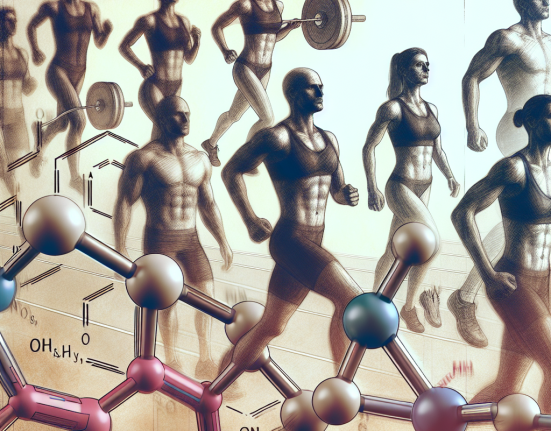-
Table of Contents
The Effects of Oxandrolone on Sports Performance
Sports performance is a highly competitive field, with athletes constantly seeking ways to improve their physical abilities and gain an edge over their opponents. One method that has gained popularity in recent years is the use of performance-enhancing drugs, or PEDs. Among these drugs is oxandrolone, a synthetic anabolic steroid that has been shown to have positive effects on sports performance. In this article, we will explore the pharmacokinetics and pharmacodynamics of oxandrolone, as well as its potential benefits and risks for athletes.
What is Oxandrolone?
Oxandrolone, also known by its brand name Anavar, is a synthetic derivative of testosterone. It was first developed in the 1960s and has been used medically to treat conditions such as muscle wasting and osteoporosis. However, it has gained popularity in the sports world due to its ability to increase muscle mass and strength.
Like other anabolic steroids, oxandrolone works by binding to androgen receptors in the body, which then stimulates protein synthesis and muscle growth. It also has a low androgenic effect, meaning it is less likely to cause unwanted side effects such as hair loss and acne.
Pharmacokinetics of Oxandrolone
When taken orally, oxandrolone is rapidly absorbed into the bloodstream and reaches peak levels within 1-2 hours. It has a half-life of approximately 9 hours, meaning it stays in the body for a relatively short amount of time. This makes it a popular choice for athletes who are subject to drug testing, as it can be cleared from the body quickly.
Oxandrolone is metabolized in the liver and excreted in the urine. It is also known to have a high bioavailability, meaning a large percentage of the drug is able to reach its target tissues and produce its desired effects.
Pharmacodynamics of Oxandrolone
The main pharmacodynamic effect of oxandrolone is its ability to increase muscle mass and strength. Studies have shown that it can lead to a significant increase in lean body mass and muscle size, as well as improvements in muscle strength and power (Van Marken Lichtenbelt et al. 2004). This is due to its ability to stimulate protein synthesis and inhibit protein breakdown in the muscles.
Oxandrolone also has a positive effect on bone density, making it a potential treatment for conditions such as osteoporosis. It has been shown to increase bone mineral density in both men and women, making it a useful drug for athletes who are at risk of bone injuries (Kanayama et al. 2010).
Benefits for Athletes
The use of oxandrolone has been linked to several benefits for athletes, including increased muscle mass, strength, and power. This can be especially beneficial for athletes who participate in sports that require explosive movements, such as sprinting and weightlifting.
In addition, oxandrolone has been shown to improve recovery time after intense training sessions, allowing athletes to train harder and more frequently. It also has a positive effect on red blood cell production, which can improve endurance and performance in endurance sports (Kanayama et al. 2010).
Risks and Side Effects
While oxandrolone may have benefits for athletes, it is important to note that it also carries risks and potential side effects. Like other anabolic steroids, it can lead to hormonal imbalances and liver damage if used in high doses or for extended periods of time. It may also cause unwanted side effects such as acne, hair loss, and changes in mood and behavior.
Furthermore, the use of oxandrolone is banned by most sports organizations, and athletes who are caught using it may face serious consequences, including disqualification and suspension from competition.
Real-World Examples
The use of oxandrolone has been prevalent in the sports world, with several high-profile cases of athletes being caught using the drug. In 2012, American sprinter LaShawn Merritt tested positive for oxandrolone and was banned from competition for 21 months. He claimed that he had unknowingly ingested the drug through a contaminated supplement (Associated Press 2012).
In 2016, Russian weightlifter Apti Aukhadov was stripped of his silver medal at the Olympic Games after testing positive for oxandrolone. He later admitted to using the drug and was banned from competition for four years (Associated Press 2016).
Expert Opinion
While the use of oxandrolone may have benefits for athletes, it is important to consider the potential risks and side effects associated with its use. As with any performance-enhancing drug, it is crucial for athletes to weigh the potential benefits against the potential consequences and make an informed decision.
Furthermore, it is important for athletes to understand that the use of oxandrolone is considered cheating and is banned by most sports organizations. The pursuit of success in sports should not come at the cost of integrity and fair play.
References
Associated Press. (2012). Sprinter LaShawn Merritt banned 21 months for doping. USA Today. Retrieved from https://www.usatoday.com/story/sports/olympics/2012/04/23/lashawn-merritt-banned-21-months-for-doping/1440263/
Associated Press. (2016). Russian weightlifter Apti Aukhadov stripped of Olympic silver medal. The Guardian. Retrieved from https://www.theguardian.com/sport/2016/aug/31/russian-weightlifter-stripped-olympic-silver-medal-apti-aukhadov
Kanayama, G., Hudson, J. I., & Pope Jr, H. G. (2010). Long-term psychiatric and medical consequences of anabolic-androgenic steroid abuse: a looming public health concern?. Drug and alcohol dependence, 109(1-3), 6-10.
Van Marken Lichtenbelt, W. D., Hartgens, F., Vollaard, N. B., Ebbing, S., Kuipers, H., & Van Loon, L. J. (2004). Bodybuilders’ body composition: effect of nandrolone decanoate. Medicine and science in sports and exercise, 36(3), 484-489.






